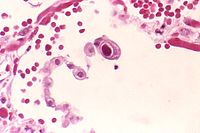
Photo from wikipedia
Genomic transposable elements (TEs) constitute the majority of the genome. Expression of TEs is known to activate the double-stranded RNA recognition pathway ("viral mimicry"), leading to the activation of interferon-stimulated… Click to show full abstract
Genomic transposable elements (TEs) constitute the majority of the genome. Expression of TEs is known to activate the double-stranded RNA recognition pathway ("viral mimicry"), leading to the activation of interferon-stimulated genes, inflammation, and immune-mediated cell death. Recently, we showed that the expression of TEs is suppressed along with immune pathways in leukemic stem cells (LSCs) in acute myeloid leukemia, suggesting a potential mechanism for immune escape of LSCs. This indicated that, during oncogenesis, where there is escape from senescence, expression of TEs is suppressed. Senescence is known to activate the interferon response and inflammatory cytokines, known as the senescence-associated secretory phenotype (SASP). We characterized the transcriptome of senescent and active human hematopoietic stem and progenitor cells (HSPCs) in vivo and showed co-occurrence of overexpression of TEs, SASP genes, and gene pathways of inflammation in senescence. The percentage of circulating senescent HSPCs (s-HSPCs) did not increase with age, indicating active clearance. Induction of senescence in human HSPCs in vitro showed increased expression of TE and SASP genes. SASP is known to mediate clearance of senescent cells and active clearance of senescent cells has been shown to increase organismal fitness. We speculate that the expression of TEs in s-HSPCs could contribute to orderly clearance of the cells via activation of immune pathways, warranting further mechanistic studies. This is the first study to characterize the transcriptome of human s-HSPCs in vivo, revealing activated expression of TEs and inflammatory genes.
Journal Title: Experimental hematology
Year Published: 2018
Link to full text (if available)
Share on Social Media: Sign Up to like & get
recommendations!